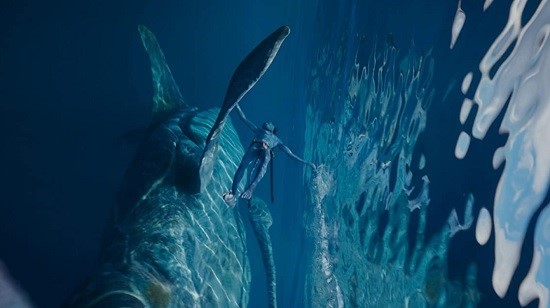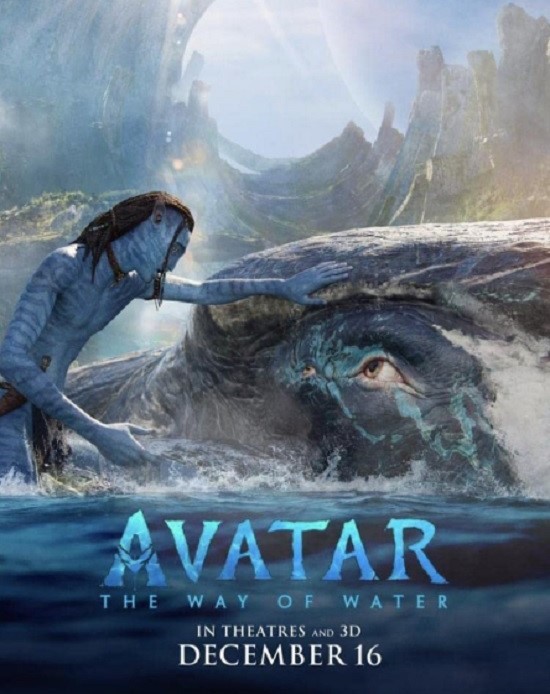The first fact you must accept
about the tulkun, a marine species introduced in “Avatar: The Way of Water”, is
that they are not whales. Director James Cameron is adamant about this.
اضافة اعلان
“I nearly got through the whole film
without calling it a whale in front of Jim,” said Dan Barrett, who served as
senior animation supervisor on the film as part of Weta FX, a famed
visual-effects company based in Wellington, New Zealand. “I did once, and you
were immediately corrected.”
Enormous in size and definitely whale-like
in their general shape, these creatures have unique anatomical characteristics
that set them apart from cetaceans here on Earth. Still, they call to mind the
whales we are familiar with in their extraordinary intelligence, their complex
systems of communication, and their intricate social structure.
A deeper connectionAccording to Rick Jaffa, one of the
screenwriters of “The Way of Water”, the tulkun collectively embody one of the
film’s main thematic undercurrents: the notion of interconnection with those
around us and with the natural world at large. Conceiving of their look and
attributes was critical in this second instalment of the “
Avatar” franchise.

As Jaffa and his co-writers — Cameron
included — began shaping the story and the characters, the art department
(located right above their office at Lightstorm, Manhattan Beach Studios, in
California) would incorporate those ideas into the designs of the creatures,
readjusting as they went along.
“You felt like you were watching evolution
in front of your own eyes,” Jaffa said.
“At first glance, yes, he’s very whalelike, but every single detail and component of him is different and alien.”
The tulkun also have a profound and ancient
relationship with the Metkayina, a Na’vi clan of oceanic people living on the
fictional moon of Pandora. It is the Metkayina who welcome Jake Sully (Sam
Worthington), the human-turned-Na’vi hero, as he and his family hide from their
enemies.
One young tulkun in particular, Payakan,
has lived in exile from the pack for years after a violent incident involving
invasive humans. But when he befriends Lo’ak (Britain Dalton), the Sullys’
rebellious middle child, Payakan shares his story and gets a redemption arc.
Payakan’s status as an outsider, Jaffa
believes, also resonates with how misunderstood Lo’ak feels within his family
unit. This sentiment of not belonging in turn mimics the experience of the
Sully family, which has been forced to find refuge away from its home in the
forest.
Over the course of the action-packed
narrative, as Payakan and Lo’ak learn more about each other, the friendship and
trust between them develops into a spiritual bond. This genuine interspecies
connection illustrates Cameron’s message of conservation.
Experimenting with posesA production designer on the sequel, Dylan
Cole has been invested in the world of Pandora since the first “Avatar”,
serving as concept art director on the 2009 film. For “The Way of Water”, Cole
said, he and his team used Payakan as the prototype for the rest of the tulkun.
But getting there involved plenty of experimentation.
“At first glance, yes, he’s very whalelike,
but every single detail and component of him is different and alien,” Cole
said.
One of the primary design requirements
involved the audio sensors on the tulkun’s crest, located on the head.
Initially, the sensor mast resembled the kind of appendage found on the head of
an anglerfish. But that version of the sensors was simplified and then removed
as Cameron himself worked on several sketches to refine the crest shape and the
way the head worked. Cole and his team took that final rendering, put the
sensors back on the crest and arrived at what we now see on screen.

Since the tulkun have armor-plated bodies
that are meant to articulate very flexibly, the art department and the
animators collaborated to create plates that would move without crashing into
one another when the creatures twist into various shapes. That outer shell
could not function like that of a sea turtle, for example; it had to be broken
up into distinct sections that would allow for what Cameron was envisioning.
“One pose Jim drew was the
tulkun arching its back with its pectoral fins all the way touching,” Cole said. “He was
imagining these dance-type poses.”
Creatures with personalityCameron had also written that the tulkun
were mouthbrooders, which in this case meant that newborn offspring of the
female tulkun reside in her mouth. The artists designed the mouth — which
reveals a large pouch when opened — as if it were an enchanted cave, since that
is where Lo’ak interacts with Payakan’s “kuru”, the word for the tendrils that
allow creatures on Pandora to mentally communicate with one another.
Cole and his team landed on an unfurling
fern coil with many points of contact for the design of Payakan’s kuru. “We
were trying to show that by having all those different kuru connections, their
connections with others are that much more powerful,” Cole said.
“I’m not only a fantasy film designer,” Cole said. “I’m a National Geographic explorer on Pandora trying to report back.”
For Payakan’s most prominent eye, his most
anthropomorphic feature, the approach entailed creating a cross between an
elephant eye and a human eye, with a familiar iris and pupil. Separately, the
sclera, the eye’s outer layer, would most closely resemble those of horses and
cows and include a nictitating membrane, the built-in goggles that make it
possible to see underwater. The goal with all of these details was to elevate
Payakan above a mere creature and give him a personality.
For Cole, who is essentially an “Avatar” zoologist,
the tulkun exemplify Cameron’s obsessive attention to the biomechanics of every
entity that inhabits this world: grounded in substantial real-world references
but imbued with enough meticulous, original details that we might almost be
convinced that these creatures actually exist somewhere out there in the
universe.
“I’m not only a fantasy film designer,”
Cole said. “I’m a National Geographic explorer on Pandora trying to report
back.”
Read more Technology
Jordan News



